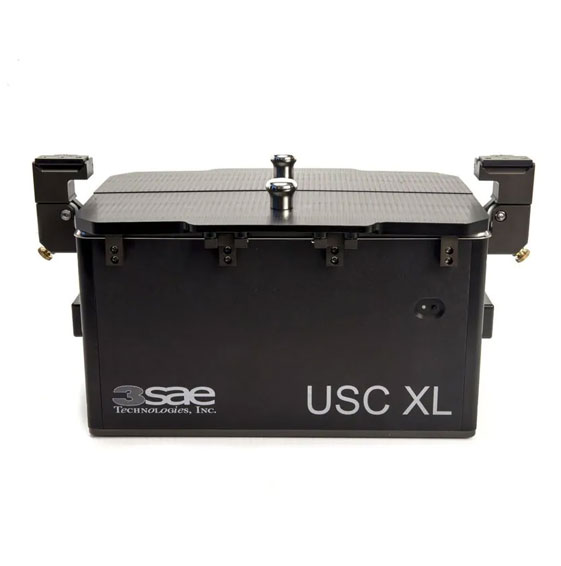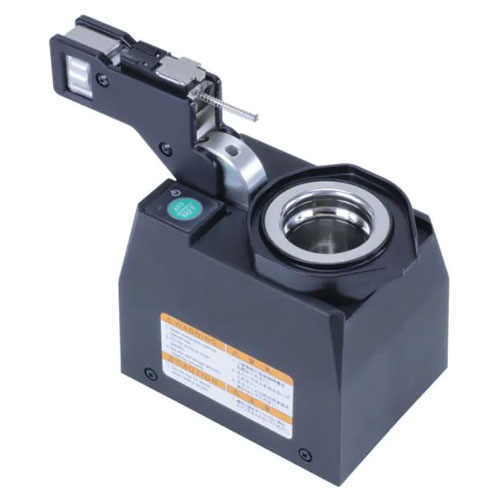To help ensure consistent polishing results, maintenance of all fiber optic polishing equipment is essential. The Preventive Maintenance program for polishing fixtures should include periodic ultrasonic cleaning. This is true for any fiber optic polishing fixtures, regardless of connector or ferrule type: connector fixtures with latching mechanisms (LC, SC), ferrule-only fixtures with screw caps or cam-locks, MT ferrule fixtures, etc.
All fixtures come from the factory with very precisely milled ferrule “bores”, tailored specifically to the particular ferrule which will be polished. These bores position the ferrule to precise angles to the polishing surface—90 degrees for PC polishing, other angles (typically 82 degrees, to create an 8-degree finish) for various APC polishing. (Note: I use the term “bore” for the circular holes milled into the fiber optic polishing fixture which hold the round ferrule, but the same concepts apply to fixture for rectangular ferrules such as MT. For simplification, this discussion will reference typical round, PC-finished ferrules, but the concepts all apply to MT fixtures as well as APC fixtures).
The level of precision to which the fixture holds the ferrules determines many of the ferrule’s geometric characteristics (Apex, Radius, Fiber Height, Ferrule Angle, etc). Contamination of the fixture can negatively affect this precision, by either pre-maturely wearing of the fixtures dimensions, or by creating buildup in the fixture, which prevents the ferrule from seating properly.
The contamination we are discussing here is primarily a natural result of the normal polishing process. Ferrules are polished on abrasive films or flock-pile pads impregnated with abrasives. During polishing, some of these abrasive particles, along with the ceramic or plastic material being removed from the ferrule itself, come free and mix with the water used as a lubricant within the process. This results in an abrasive slurry that contaminates the fixture and the ferrules themselves. Common polishing practices require the operator to clean the bottom of the fixture between polishing cycles, to remove abrasive particles that may create fiber end-face scratches in subsequent polishing steps. However, this slurry can (and will) migrate into crevices and the bores of the fixture—places difficult or unlikely to be fully cleaned or flushed out during the normal polishing process. Allowed to dry, it will harden and cake.
The 4 major effects of this contamination to consider:
Contamination within the ferrule bore is wearing the bore, creating a larger bore diameter: Ferrule bore wear is unavoidable over time—as thousands of ceramic ferrules are inserted and removed from a stainless steel fixture, the bore will wear. However, contamination of the bore, particularly with abrasive particles naturally resulting from the polishing process (the “slurry” referred to above), can accelerate this wear. As the bore diameter becomes larger, the ferrule is held to less than 90 degrees to the polishing surface, resulting in larger Apex Offset and Angle values.
Contamination within the ferrule bore is building up, “pushing” the ferrule to one side: the slurry generated from polishing can accumulate in the bore or other areas of the fixture, building up to prevent the ferrule from seating at precisely 90 degrees to the polishing surface. This can also result in large Apex Offset and Angle values. This buildup issue is often seen in MT ferrule polishing fixtures.
Contamination within the ferrule bore prevents the ferrule from sliding freely within the bore: This mainly applies to connector polishing (as opposed to ferrule-only polishing) where the connector’s spring force is relied on to present equal downward pressure to the ferrules during polishing. The ferrules in a connector fiber optic polishing fixture must be able to piston up and down freely in the fixture. If contamination of the ferrule bore holds the ferrule too tightly, this may “lock-up” the ferrules or prevent them from pistoning consistently / smoothly within the bore during polishing. This, in turn, will result in different pressures being applied to the end-faces during polishing—–which creates variation in Radius values, FH values, and fiber end-face polish quality (scratches).
Contamination on the fixture prevents ferrules from protruding an equal distance from the base of the fixture. This mainly applies to fixtures for polishing ferrule only (as opposed to connector polishing). The ferrules must protrude the same amount from the bottom of the fiber optic polishing fixture, to ensure consistent pressure being applied to all ferrules. Contamination at the top of the bore, where the ferrule flange sits on, will cause the ferrules to sit higher and protrude less. If ferrules are protruding different lengths from the bottom of the fixture, this results in unequal pressures being applied to the ferrules during polishing, again resulting in variation in Radius values, FH values, and fiber end-face polish quality (scratches).
The most effective way to reduce the effects of such contamination is to thoroughly clean the fixtures between use, by rinsing with distilled water immediately after polishing, to prevent the “surry” from drying. Even so, particularly with fixture having many recessed faces or “nooks and crannies”, it is good practice to give each fixture a more rigorous cleaning after use, when the fixture will be not be in use for some time (such as at end of shift). Ultrasonic cleaning, in combination with brush-cleaning the bores, works very well for this type of cleaning, and it is recommended that cleaning be part of a daily Preventive Maintenance program for all fiber optic polishing fixtures.
Ultrasonic Cleaning:
- Ultrasonic cleaners are a bath into which the object to be cleaned is submerged. The bath is usually of distilled water, which can be augmented with detergents or solvents or other cleaners. For cleaning of polishing fixtures, an ultrasonic bath of only distilled water is sufficient and recommended over other solutions.
- The walls of an ultrasonic cleaner vibrate and a particularly high frequency, transferring pressure waves to the water. These waves have the effect of pushing and pulling the water molecules to create “cavitation”: essentially “tearing” the water molecules apart, creating a very short-lasting “bubble” of vacuum within the water, which very quickly—and forcefully—implodes. The energy of this collapse, which occurs near the surface of the submerged object, is what creates the agitation to remove contaminants from the surface.
- Because the cavitation occurs within the water medium only, it is important that the entire object be submerged, with no air bubbles trapped in areas to be cleaned. As long as the surfaces to be cleaned are in contact with the water, and because the cavitation happens on the molecular level, the cleaning effect can reach into very small crevices and is ideal for fiber optic polishing fixture cleaning.
- It is important to note that the cavitation is created by the physical movement of the sidewalls of the cleaner and that most ultrasonic cleaners are calibrated such that most of the cavitation power occurs somewhere in the middle of the bath. It is important that objects to be cleaned are suspended within the bathwater, and do NOT contact the bottom or interior walls of the ultrasonic cleaner. Objects contacting the bottom or sidewalls of the cleaner will reduce their movement, and thus reduce the cavitation effect.
Following up the ultrasonic cleaning with a brushing of the ferrule bores and blowing dry with clean, compressed air will help to ensure maximum life and performance of the fiber optic polishing fixture.
Fiber Optic Center is a resource for questions on this and all technical subjects. AskFOC can be found at: https://focenter.com/askfoc/ and the Fiber Optic Center technical experts will answer your questions here.






